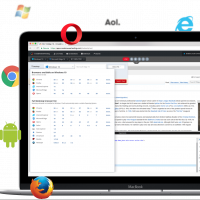The Cross-Browser Testing Landscape Is Ready for DevOps

The digital transformation is behind us—now it’s all about maximizing the impact of the digital and internet of things landscapes for greater user engagement and business outcomes. And while it was mostly mobile driving this transformation before, we are now starting to see the “new” web become an integral part.
While most websites today use responsive web design (RWD), there is a significant growth in the adoption of progressive web apps (PWAs) as a new way of engagement. PWAs are transforming the end-user experience by providing cross-platform mobile and web capabilities from within a web app, with unique mobile-specific features.
Having such advanced websites—whether high-performing, responsive, or progressive—is prioritized by Google from a ranking perspective, and that’s important in a competitive market.
Add to this maturing practices around agile development and testing and greater adoption of behavior-driven development practices with tools like Cucumber and Gauge, as well as other CI/CD optimized processes for delivering software, and the landscape lends itself well to the transformation that is also being experienced in the tools ecosystem, both commercial and open source.
It is important to heed the impact of growing trends around RWD and PWAs so teams can prepare their test labs and tools. Get familiar with leading frameworks, like Selenium and Google Lighthouse, and embedded tools within IDEs like Android Studio that can help monitor apps and provide the proper object identifications. With the shift to agile and continuous testing, there is also a growing role for headless browsers in the overall DevOps pipeline, with a focus on tools such as Google Puppeteer, JSDom, and more.
But let’s not forget the majority of websites today that are responsive. For these, teams need to be familiar with the most common frameworks that are in use in the market, including WebdriverIO, Selenium, CodeceptJS, Protractor, and Gauge BDD.
Regardless of the web application type, teams often neglect the investment in nonfunctional testing to assure UX, accessibility, and performance of their cross-browser web applications. It is important to realize the business benefits of in-browser dev tools such as Lighthouse, Edge, and Firefox tools that can play an instrumental role in assuring both functional and nonfunctional quality.
With all the different tools, app types, and DevOps practices, the remaining task for teams is to have a proper set of considerations for how to choose from all these tools, such as:
- Community and documentation efficiency
- Technical fit to the app technology (e.g., support for the web development framework)
- Rich reporting
- Tool chain integration and plugins
When navigating the cross-browser testing landscape that now includes new tools and practices, it’s important to adopt the ones that will assure high testing productivity and a good team fit.
Eran Kinsbruner is presenting the session Strategies for Selecting the Right Open Source Framework for Cross-Browser Testing at Agile Dev, Better Software & DevOps West 2018, June 3–8 in Las Vegas, Nevada.

